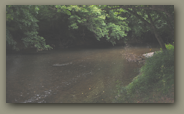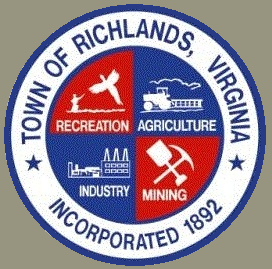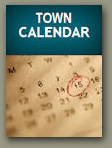About our Town

Historical Links
The Academic Encyclopedias
Tazewell County Historical Society
Wikipedia
Take A Photo Tour
In the land now containing the town of Richlands a Native American village probably once stood. As late as 1775, the area containing the future town of Richlands held the line as a western outpost of
civilization. Forts and militiamen offered refuge and protection to pioneer families during native tribal raids. Not until December 1792 did civilization push its borders into Kentucky, and the area
was no longer a military outpost.
Before the Civil War, Richlands was once a farm owned by William M. Gillespie, whose big log house stood near the present site of Cury’s Store. One Gillespie descendant believes the home stood closer to the Williams house (Richlands Public Library). Corn was the principal crop on Mr. Gillespie’s farm. As corn was not easily transported, corn farmers either converted their crop to whiskey or utilized the corn to raise hogs. The Gillespie farm in Richlands was a hog-feeding station. Farmers in Kentucky and other points west drove their hogs to market-seaports such as Charleston, South Carolina, and Savannah, Georgia—where the slaughtered hogs became salted pork for the sailing ships. Along their route to theses markets, farmers stopped for weeks at hog-feeding stations to fatten the hogs.
In the 1890’s touted to speculators and investors as the “Pittsburg of the South,” Richlands began with promises for riches and success. The Clinch Valley Coal and Iron Company, a conglomerate of seven companies, purchased extensive holdings in the valley. Historian William Pendleton estimated the Richlands area as measuring two by four miles with five thousand acres of “very valuable land.” Clinch Valley Coal and Iron properties extended through the outlying territories of Indian Creek, Middle Creek, Town Hill Creek, Swords Creek, Dumps Creek, Weaver’s Creek, and Big Creek. The company in turn leased these properties to various people.
The name Richlands evolved from the land grant of 1785 from Patrick Henry, then governor of Virginia, to a John Fowler for a tract of two hundred acres extending from Lake Park (Lick Lot then) to Doran. The grant described the land location as “in the rich lands on both sides of the Upper Fork of the Clinch River.” As pronounced in that document, both words wereand are accented equally Rich-lands. Historian Bickley commented that Richlands was “…noted for its fine lands. It is a pretty place, and desirable.”
Richlands went “on line” around 1889 when the Norfolk and Western Railroad arrived. Across from the Eagle and Dixie hotels (the area between where today The Tazewell County Free Press and The Richlands News Press operate) stood the brick Richlands depot. By 1890, the town had established a street system and industrial sites. That same year the town contained a large office building, a bank, and the luxurious, Hotel Richlands. At the factory on Iron Street, behind what is today the Richlands post office, rolling mill workers converted cast iron into wrought iron. Known as puddlers, these imported employees lived on Puddler’s Row. R. L. Crawford’s History of Richlands states the glass factory never operated. Constructed across the railroad from First Sentinel Bank, the factory had hired glass blowers-mainly skilled European artisans-whose houses were in “Glass Row,” now Alleghany Street. Rumors flew that a barites (a chemical used in making glass and paint) plant would replace the factory. With this industrial expansion came roads, a water system, and new housing. In 1890, Bob Kitts came to work in the new boom town. “Uncle Bob” said the new Clinch Valley Coal and Iron Company moved fast. Wanting to bring his parents to Richlands and to involve his family in the new company, Uncle Bob asked the company to build him a house. They agreed. After choosing a site in the Brooklyn Addition, he went home to Russell County to move his family. A week later when the Kitts family returned with their belongings on wagons, their house-the first completed residence in the new town-was ready.Norfolk & Western Railroad Depot building around 1890.
In 1892, Richlands became incorporated, but with the stock market crash in 1893, the bubble burst; first came depression and then, regression. Northern companies ordered their agents home, closing factories, mills, and the Hotel Richlands. When the rolling mill closed, the company demolished the mill and hauled away the remains. Realizing the hotel now stood empty, residents carried away the sterling silver, the Dresden china marked The Hotel Richlands in gold, crystal chandeliers, and mahogany furniture. One local home contains the swinging doors to the men’s bar.
The citizens who remained suffered hard times. Eggs sold for five cents a dozen, and reportedly butter greased the wagon axles. Through it all, people managed to survive the crisis. In time, Hotel Richlands became old Dominion College for a few years; the brick factory, of which is not a vestige remains. An up-close view of the grand Hotel Richlands, built by the Clinch Valley Coal and Iron Company who came to “boom” the town reopened and functioned until 1982; the bank reorganized; and the town continued. In regard to moving ahead, President Harry S. Truman said, “Men make history and not the other way ‘round. In periods where there is no leadership, society stands still. Progress occurs when courageous, skillful leaders seize the opportunity to change things for the better.” Education fared better than economy in the early Richlands years. As early as October 1891, the Clinch Valley News reported that J.A. Leslie would establish a high school in Richlands. This high school included all grade levels; a four-year system would eventually materialize.
Mr. A. L. Graybeal, hired on September 19, 1892, taught in the new town with Miss Lucy Stuart-whose salary was twenty dollars a month-as assistant teacher. The town paid brothers J. Muncey and George W. Ratliff to use an upstairs room in the building known then as Ratliff Brothers Hall located at the corner of Front and Fairfax. A month later the town rented a room for Miss Stuart, paying four dollars, in the same building which later became known as the Hankins-Beavers building.Mr. George Kyd taught classes for black students in the black Baptist Church, probably located on Kents Ridge Road. He received $27.50 monthly until his salary and the salary of Miss Stuart decreased, possibly due to lack of revenue.Richlands residents supported local effort, even paying one-half the cost of the last school building erected in the 1929 development. At one time Richlands even became a separate school district. Such independence and town pride prompted local citizens to seek location of the courthouse and county seat at Richlands. Some school “firsts” include the fact that Boyd Boggess was the first graduate of Richlands High School in 1909. R. L. Crawford, later a town historian, operated the first bus to transport Richlands pupils.
At some later time, the C. C. Selfe line supplied transportation. Also, the 1933 football team was the first to play on the mid-town field now replaced by Ernie Hicks Stadium behind the present high school. Until the fall of 1976 when the middle school opened, the 1929 building still served as a school. In 1979, J.R. “Bob” Mullins purchased the entire 1929 school plant; he razed the older sections, renovated the newer section, added a third floor, and encased the exterior in gray-coated glass. The Mullins Professional Building stands on the 1929 site of Richlands High School. Embedded at the corner of Second Street and Allegheny Street is the original engraved name stone from the old high school.
Familiar faculty in the 1929 yearbook included teacher of English , Josephine Brown, who later became Mrs. Joe White; and Assistant Principal and teacher of Latin, K.M. Hicks, beloved Coach “Ernie” Hicks of later days. The yearbook also listed teacher of French, Mary Williams, daughter of Dr. W. R. Williams; and principal C. R. Six. Students of the 1940’s will remember Richlands schools suffered from overcrowding. Resulting from this problem was the “stagger” system: one group of students began and ended classes early while the second group began and ended later. To further remedy the overcrowding, “chicken coops” served as classrooms until the new high school opened in 1953. Theses raw wooden structures with windows on one side and a pot-bellied stove for winter faced each other across the lawn of RHS. Other “new” rooms, sectioned off the ends of hallways, alleviated some congestion.
Although, the coal industry was not the heart of Richlands, Richlands was certainly the heart of the coal industry. Local coal mining included operations at Big Creek, Seaboard, Hill Creek, Doran, and Raven, as well as Middle Creek and Indian Creek at Cedar Bluff, according to the Richlands-News Press Centennial Edition. Dependent on that coal was the brick plant located off Kents Ridge Road. Dating to 1890 when the town had iron, ice, and glass factories, the brick plant alone survived. Howard E. Steele, in a news article of 1923, wrote that the brick plant was “ the town’s most important industry.”
During World War II the plant supplied 95% of its products to the war effort. In 1908 bankruptcy notices on the plant became public. Mr. C. C. Hyatt purchased the business in 1911 and continued the plant until ill health led him to lease the plant to General Shale Corporation. A. H. Kelly assumed management until his retirement in 1964. In that year production numbers listed 80,000 bricks made daily with plans of doubling that with future installation of four new kilns. Using as much as thirty tons of local coal per day, the plant remained for a long time a major purchaser of coal. However, by 1973, General Shale had converted all but one of its Richlands coal-burning plants to gas operation.
In 1892, the business begun in the 1890’s closed. Of the operation that once extended from the shale pits located on the east and west ends of town to the massive plant on Kent’s Ridge, there remains a shopping center and a parking lot. Perhaps a Civil War chaplain, Abram Joseph Ryan, said it most appropriately: “A land without ruins is a land without memories-a land without memories is a land without history.” As recalled by one of the first citizens, “Uncle Bob” Kitts, the office building of the Clinch Valley Coal and Iron Company later became the residence of Dr. William Reese Williams. Now utilized as the Richlands Branch of the Tazewell County Public Library system, the building at the corner of Suffolk and Front Street still has, at the left of the front door, the small octagonal window used by the company paymaster.
On Washington Square, the hub of the town, the Hotel Richlands became the focal point of the 1890’s development. A few years after the company abandoned the hotel, one Alsom Hutton leased the building as the Old Dominion College. For six years the college offered education, culture, and entertainment to the community before finally closing its doors. After a fire destroyed much of the structure, Dr. W. R. Williams built the Mattie Williams Hospital on that site in 1915. He named it for his wife Mattie Lou Peery-Williams, sister of Gov. George C. Peery.
In 1917, J. A. Leslie recorded his observations on the hospital. “The building is imposing,” he stated, “standing as it does upon an elevated plateau, overlooking the town. The brick building has tall white columns on the front, approached by granolithic walks. The sanitarium…has ‘put Richlands on the map, […] ” The hospital maintained the Mattie Williams Hospital School of Nursing from approximately 1926 to 1935. The first staff nurses, who were the teaching nurses as well, were Miss Cope and Miss Lismoore. Both women were British and observed “high tea” each day. The training school employed local medical professionals to teach the classes. Among others, Dr. E. L. Jackson, local pharmacist, taught chemistry. Dr. Isaac Wickham Cunningham, well known and respected local physician, taught anatomy.
A unique feature of the school was the ninth-month training period at Norfolk General Hospital. After completing training in Richlands, the student nurses traveled by train to Norfolk where they received further training while working twelve-hour shifts. Reportedly, the Mattie Williams Hospital nurses were so well trained that some competition arose among Norfolk personnel as to which floors would gain the Richlands nurses. After this stay in Norfolk, the students sat for examinations to license them as registered nurses. Many scored high on the state test.Dr. W. R. Williams died July 19, 1943. Dr. James P. Williams continued his father’s work until Dr. James death in 1961. Another member of the Mattie Williams family was Mattie’s nephew, James Peery. Medicine was figuratively in the blood as Dr. Peery’s grandfather was a Civil War surgeon.
During World War II, Dr. Peery encountered one of Japan’s most famous military figures. After Japan has surrendered, Dr. Peery served in an American hospital there. When summoned to the emergency room one day, he learned that Japanese General Tojo, soon to be arrested for war crime charges, had attempted “Hari Kari” with an American .38 automatic. Dr. Peery, expressing amazement that the bullet had missed the famous general’s heart, aspirated the blood in the man’s chest. Dr. Peery said that Tojo did not want to live but that once he knew he would recover, he was a good patient. Tried and convicted for war crimes, Tojo hanged a few months later.
After 1990, The Mattie closed for the last time. Following much heated debate, the town officials voted to obliterate the structure. Another hospital served Richlands and vicinity. As a result of treating accidents, injuries, and illnesses of Richlands area miners, Bluefield Sanitarium officials decided to build a hospital in Richlands. On January 1, 1938, the three-floor Richlands brick and Indiana limestone hospital opened on a thirty-two acre tract. Medical staff included Dr. J. A. Robinson, medical director; Dr. Joseph W. Houck, surgeon; and Dr. H. Lee Harris, who was an eye, ear, nose, and throat specialist. Joe H. Douthat was laboratory director while Mrs. Douthat acted as office manager, Dr. G.D. Vermilya soon joined the group.
Operating with a patient capacity of 69 in 1938, the hospital used only floors A, B, and G, the basement level. The top floor, C floor, housed personnel until housing for nurses and physicians became available. During the first year, the hospital records show 1,643 patients admitted and 49 births. Upon completion of the nearby nurses’ home, the C-floor space provided the hospital a 100-bed capacity. By the 1950’s, the need for more beds produced a west wing, opening on July 1, 1954, increasing capacity to 135 beds. Answering further need for space, the adjacent Clinic Building opened September 1, 1963, to house the increased staff of physicians, medical records, x-ray department, laboratory, and emergency department. In the 1970’s the clinic added two upper floors.
In 1977 and ownership transfer led to the dissolving of the partnership. By 1978, Humana, Inc., had purchased the institution, the practicing group had become Clinch Valley Physicians, and the hospital’s name was Clinch Valley Community Hospital. Records of 1982 showed the hospital had admitted 8,475 patients and delivered 603 babies. By this time, the number of physicians exceeded forty and employees numbered 350. Based on the July 1981 certificate of need application approval, Humana Hospital Clinch Valley opened in August 1983 and demolished the Clinch Valley Clinic Hospital on August 28, preparatory to building a new hospital.
Three structures of those early boom years remain. The first bank, built in 1890 and established in 1891, remains on the corner of Front Street and Suffolk Avenue. The bank sat directly across from another landmark, the company office building that later became Dr. William’s residence. The third remaining building is the W.B.F. White and Sons hardware store at the corner of Second Street and Railroad Avenue, established in 1892. On the railroad side of the store is the Ellen Elmes mural depicting the early Richlands years. Descendant James S. White recalls hearing that timbers from the glass factory/barites plant went into the hardware store. Directly in front of the hardware store is the First Christian Church, at the corner ofSecond Street and Norfolk Avenue. This church is the oldest church in the community, having been constructed in 1908.In addition to the famed Hotel Richlands, two other hostelries existed at various periods. Ball Hotel, located at the site of the current Richlands Police Department, housed patrons that were often traveling salesmen. The Richlands Inn, located near the site of the Dalton/Ervin Davis Building, probably held one of the town’s saloon.
In 1890 Richlands published its first newspaper, Richlands News, that ran 1890 to 1895. The Enterprise, published by G. C. Harris, operated from 1911 to 1917, and The Southwest News, 1932. Charles R. Greever established The Richlands Press in 1945 after George Beale began the News Progress in 1937. Both papers ran independently until 1966 when the two papers merged as the Richlands News-Press.
In the middle 1900’s, Richlands businesses prospered. Hard work effected the success of the Cury, Draper, Horton, Nassif, and Roydon families as clothiers. Patsy and Marco Warner established stores, and Warner’s Wholesale and Dixie Wholesale became big businesses. Generations of teenagers will remember Dr. Greever and Dr. Repass and their Rexall Drug Store where young people could enjoy various confections and the latest records on the juke box. Earl Hurt sold everything from flowers to men’s clothing. Paul Buskill began as a businessman with his Jobber’s Supply and Buskill Brokerage. Mr. Guy Flanary’s establishments entertained generations of movie lovers and supplied stages for high school productions and baccalaureate services. Mr. Flanary also did much to curtail juvenile problems with his practice of providing free tickets for those boys who had gone to Sunday school/church. Mr. Flanary established a Boys Club that met for regular programs on Sunday afternoons. During the war, Mr. Flanary also provided free tickets for servicemen on furlough. Also remembered were the Farmer Funeral Home and Hurst-Scott Funeral Home, whose ties to the community were long standing.
Among the many names associated with successful businesses of the 1940’s and 1950’s, these are just a few.From all reports of those early Richlands days, including Mr. R. L. Crawford’s, Richlands was “wild and woolly.” Reportedly, twenty-seven saloons operated in the town and outlying communities. Among the nine attributed to the town of Richlands were the following: one, managed by Jake Litchenstein, was located at the corner of Front Street and Norfolk Avenue where Easley’s Florist Shop stood; a second, where the Dalton building stands on Front Street, possibly within the Richlands Inn; the third, operated by Ike Greenberg, stood adjacent to the W. B. F. White and Son building; the fourth, operated by Ike Litchenstein, was on the site of the Rexall Drug Store at the corner of Front Street and Railroad Avenue; the fifth saloon on Railroad Avenue, run by Max Greenberg, stood behind what later was the Rexall Drug Store; the sixth one, operated by Henry Litchenstein, was located in the Hurt building on Suffolk Avenue; the seventh one, run by Cotter and Lazarus, was situated on Second Street between the hardware store and Hurst-Scott Funeral Home; the eighth one, operated by J. E. Lester, stood in the Brick Yard near the kilns; and last was the basement bar, operated by Bill Estes, in the famed Hotel Richlands. A local minister stated that six saloons on Main Street (Front Street) dispensed liquor and advised women and decent men to avoid those places.
Sometimes on horseback or muleback, the rowdy and often inebriated rider would take his mount and himself through the saloon doors. The streets were not safe; shootings and killings were not rare. Legal action and special volunteer police attempted to protect the town from “desperadoes,” “town-takers,” and “ruffians.” In most cases, order prevailed; however, the shameful lynching of five black men occurred when a mob overpowered police.
One positive force was Robert Sheffey, the Methodist circuit-riding minister about whom Jess Carr wrote The Saint of the Wilderness. In more than one instance, Sheffey called the town’s attentions to its shortcomings. Sheffey supposedly brought the local option to vote and helped defeat those candidates who supported the sale of liquor.At another time when Brother Sheffey visited Richlands, the open obscenity, many taverns, and more drunks shocked Sheffey. Walking through the business area one day, he stopped by a house (probably on the east end of Richlands), listening through the open window to laughter and loud male voices within. When a dust-covered miner walked by, Sheffey inquired as to the nature of the business in the house and learned it was a house of ill repute. Retreating through an alleyway, he recognized three boys he had seen earlier in an orchard. He offered them a half dollar if they would bring him the object at which the boys had been throwing rocks that morning. They agreed and in due time produced the object, plugged with a corncob and wrapped in a sack. Moving under the open window of the bordello, Sheffey hurled the object inside. Seeing it burst, he reached up and pulled down the window with great force. As he left the premises, he heard male and female cries of pain and agony as the live hornet’s nest did its work.
Information was compiled by Carol Wolfe and Gaynelle Thompson and published by the Tazewell County Historical Society Click Here for link to the Academic Encyclopedias
Before the Civil War, Richlands was once a farm owned by William M. Gillespie, whose big log house stood near the present site of Cury’s Store. One Gillespie descendant believes the home stood closer to the Williams house (Richlands Public Library). Corn was the principal crop on Mr. Gillespie’s farm. As corn was not easily transported, corn farmers either converted their crop to whiskey or utilized the corn to raise hogs. The Gillespie farm in Richlands was a hog-feeding station. Farmers in Kentucky and other points west drove their hogs to market-seaports such as Charleston, South Carolina, and Savannah, Georgia—where the slaughtered hogs became salted pork for the sailing ships. Along their route to theses markets, farmers stopped for weeks at hog-feeding stations to fatten the hogs.
In the 1890’s touted to speculators and investors as the “Pittsburg of the South,” Richlands began with promises for riches and success. The Clinch Valley Coal and Iron Company, a conglomerate of seven companies, purchased extensive holdings in the valley. Historian William Pendleton estimated the Richlands area as measuring two by four miles with five thousand acres of “very valuable land.” Clinch Valley Coal and Iron properties extended through the outlying territories of Indian Creek, Middle Creek, Town Hill Creek, Swords Creek, Dumps Creek, Weaver’s Creek, and Big Creek. The company in turn leased these properties to various people.
The name Richlands evolved from the land grant of 1785 from Patrick Henry, then governor of Virginia, to a John Fowler for a tract of two hundred acres extending from Lake Park (Lick Lot then) to Doran. The grant described the land location as “in the rich lands on both sides of the Upper Fork of the Clinch River.” As pronounced in that document, both words wereand are accented equally Rich-lands. Historian Bickley commented that Richlands was “…noted for its fine lands. It is a pretty place, and desirable.”
Richlands went “on line” around 1889 when the Norfolk and Western Railroad arrived. Across from the Eagle and Dixie hotels (the area between where today The Tazewell County Free Press and The Richlands News Press operate) stood the brick Richlands depot. By 1890, the town had established a street system and industrial sites. That same year the town contained a large office building, a bank, and the luxurious, Hotel Richlands. At the factory on Iron Street, behind what is today the Richlands post office, rolling mill workers converted cast iron into wrought iron. Known as puddlers, these imported employees lived on Puddler’s Row. R. L. Crawford’s History of Richlands states the glass factory never operated. Constructed across the railroad from First Sentinel Bank, the factory had hired glass blowers-mainly skilled European artisans-whose houses were in “Glass Row,” now Alleghany Street. Rumors flew that a barites (a chemical used in making glass and paint) plant would replace the factory. With this industrial expansion came roads, a water system, and new housing. In 1890, Bob Kitts came to work in the new boom town. “Uncle Bob” said the new Clinch Valley Coal and Iron Company moved fast. Wanting to bring his parents to Richlands and to involve his family in the new company, Uncle Bob asked the company to build him a house. They agreed. After choosing a site in the Brooklyn Addition, he went home to Russell County to move his family. A week later when the Kitts family returned with their belongings on wagons, their house-the first completed residence in the new town-was ready.Norfolk & Western Railroad Depot building around 1890.
In 1892, Richlands became incorporated, but with the stock market crash in 1893, the bubble burst; first came depression and then, regression. Northern companies ordered their agents home, closing factories, mills, and the Hotel Richlands. When the rolling mill closed, the company demolished the mill and hauled away the remains. Realizing the hotel now stood empty, residents carried away the sterling silver, the Dresden china marked The Hotel Richlands in gold, crystal chandeliers, and mahogany furniture. One local home contains the swinging doors to the men’s bar.
The citizens who remained suffered hard times. Eggs sold for five cents a dozen, and reportedly butter greased the wagon axles. Through it all, people managed to survive the crisis. In time, Hotel Richlands became old Dominion College for a few years; the brick factory, of which is not a vestige remains. An up-close view of the grand Hotel Richlands, built by the Clinch Valley Coal and Iron Company who came to “boom” the town reopened and functioned until 1982; the bank reorganized; and the town continued. In regard to moving ahead, President Harry S. Truman said, “Men make history and not the other way ‘round. In periods where there is no leadership, society stands still. Progress occurs when courageous, skillful leaders seize the opportunity to change things for the better.” Education fared better than economy in the early Richlands years. As early as October 1891, the Clinch Valley News reported that J.A. Leslie would establish a high school in Richlands. This high school included all grade levels; a four-year system would eventually materialize.
Mr. A. L. Graybeal, hired on September 19, 1892, taught in the new town with Miss Lucy Stuart-whose salary was twenty dollars a month-as assistant teacher. The town paid brothers J. Muncey and George W. Ratliff to use an upstairs room in the building known then as Ratliff Brothers Hall located at the corner of Front and Fairfax. A month later the town rented a room for Miss Stuart, paying four dollars, in the same building which later became known as the Hankins-Beavers building.Mr. George Kyd taught classes for black students in the black Baptist Church, probably located on Kents Ridge Road. He received $27.50 monthly until his salary and the salary of Miss Stuart decreased, possibly due to lack of revenue.Richlands residents supported local effort, even paying one-half the cost of the last school building erected in the 1929 development. At one time Richlands even became a separate school district. Such independence and town pride prompted local citizens to seek location of the courthouse and county seat at Richlands. Some school “firsts” include the fact that Boyd Boggess was the first graduate of Richlands High School in 1909. R. L. Crawford, later a town historian, operated the first bus to transport Richlands pupils.
At some later time, the C. C. Selfe line supplied transportation. Also, the 1933 football team was the first to play on the mid-town field now replaced by Ernie Hicks Stadium behind the present high school. Until the fall of 1976 when the middle school opened, the 1929 building still served as a school. In 1979, J.R. “Bob” Mullins purchased the entire 1929 school plant; he razed the older sections, renovated the newer section, added a third floor, and encased the exterior in gray-coated glass. The Mullins Professional Building stands on the 1929 site of Richlands High School. Embedded at the corner of Second Street and Allegheny Street is the original engraved name stone from the old high school.
Familiar faculty in the 1929 yearbook included teacher of English , Josephine Brown, who later became Mrs. Joe White; and Assistant Principal and teacher of Latin, K.M. Hicks, beloved Coach “Ernie” Hicks of later days. The yearbook also listed teacher of French, Mary Williams, daughter of Dr. W. R. Williams; and principal C. R. Six. Students of the 1940’s will remember Richlands schools suffered from overcrowding. Resulting from this problem was the “stagger” system: one group of students began and ended classes early while the second group began and ended later. To further remedy the overcrowding, “chicken coops” served as classrooms until the new high school opened in 1953. Theses raw wooden structures with windows on one side and a pot-bellied stove for winter faced each other across the lawn of RHS. Other “new” rooms, sectioned off the ends of hallways, alleviated some congestion.
Although, the coal industry was not the heart of Richlands, Richlands was certainly the heart of the coal industry. Local coal mining included operations at Big Creek, Seaboard, Hill Creek, Doran, and Raven, as well as Middle Creek and Indian Creek at Cedar Bluff, according to the Richlands-News Press Centennial Edition. Dependent on that coal was the brick plant located off Kents Ridge Road. Dating to 1890 when the town had iron, ice, and glass factories, the brick plant alone survived. Howard E. Steele, in a news article of 1923, wrote that the brick plant was “ the town’s most important industry.”
During World War II the plant supplied 95% of its products to the war effort. In 1908 bankruptcy notices on the plant became public. Mr. C. C. Hyatt purchased the business in 1911 and continued the plant until ill health led him to lease the plant to General Shale Corporation. A. H. Kelly assumed management until his retirement in 1964. In that year production numbers listed 80,000 bricks made daily with plans of doubling that with future installation of four new kilns. Using as much as thirty tons of local coal per day, the plant remained for a long time a major purchaser of coal. However, by 1973, General Shale had converted all but one of its Richlands coal-burning plants to gas operation.
In 1892, the business begun in the 1890’s closed. Of the operation that once extended from the shale pits located on the east and west ends of town to the massive plant on Kent’s Ridge, there remains a shopping center and a parking lot. Perhaps a Civil War chaplain, Abram Joseph Ryan, said it most appropriately: “A land without ruins is a land without memories-a land without memories is a land without history.” As recalled by one of the first citizens, “Uncle Bob” Kitts, the office building of the Clinch Valley Coal and Iron Company later became the residence of Dr. William Reese Williams. Now utilized as the Richlands Branch of the Tazewell County Public Library system, the building at the corner of Suffolk and Front Street still has, at the left of the front door, the small octagonal window used by the company paymaster.
On Washington Square, the hub of the town, the Hotel Richlands became the focal point of the 1890’s development. A few years after the company abandoned the hotel, one Alsom Hutton leased the building as the Old Dominion College. For six years the college offered education, culture, and entertainment to the community before finally closing its doors. After a fire destroyed much of the structure, Dr. W. R. Williams built the Mattie Williams Hospital on that site in 1915. He named it for his wife Mattie Lou Peery-Williams, sister of Gov. George C. Peery.
In 1917, J. A. Leslie recorded his observations on the hospital. “The building is imposing,” he stated, “standing as it does upon an elevated plateau, overlooking the town. The brick building has tall white columns on the front, approached by granolithic walks. The sanitarium…has ‘put Richlands on the map, […] ” The hospital maintained the Mattie Williams Hospital School of Nursing from approximately 1926 to 1935. The first staff nurses, who were the teaching nurses as well, were Miss Cope and Miss Lismoore. Both women were British and observed “high tea” each day. The training school employed local medical professionals to teach the classes. Among others, Dr. E. L. Jackson, local pharmacist, taught chemistry. Dr. Isaac Wickham Cunningham, well known and respected local physician, taught anatomy.
A unique feature of the school was the ninth-month training period at Norfolk General Hospital. After completing training in Richlands, the student nurses traveled by train to Norfolk where they received further training while working twelve-hour shifts. Reportedly, the Mattie Williams Hospital nurses were so well trained that some competition arose among Norfolk personnel as to which floors would gain the Richlands nurses. After this stay in Norfolk, the students sat for examinations to license them as registered nurses. Many scored high on the state test.Dr. W. R. Williams died July 19, 1943. Dr. James P. Williams continued his father’s work until Dr. James death in 1961. Another member of the Mattie Williams family was Mattie’s nephew, James Peery. Medicine was figuratively in the blood as Dr. Peery’s grandfather was a Civil War surgeon.
During World War II, Dr. Peery encountered one of Japan’s most famous military figures. After Japan has surrendered, Dr. Peery served in an American hospital there. When summoned to the emergency room one day, he learned that Japanese General Tojo, soon to be arrested for war crime charges, had attempted “Hari Kari” with an American .38 automatic. Dr. Peery, expressing amazement that the bullet had missed the famous general’s heart, aspirated the blood in the man’s chest. Dr. Peery said that Tojo did not want to live but that once he knew he would recover, he was a good patient. Tried and convicted for war crimes, Tojo hanged a few months later.
After 1990, The Mattie closed for the last time. Following much heated debate, the town officials voted to obliterate the structure. Another hospital served Richlands and vicinity. As a result of treating accidents, injuries, and illnesses of Richlands area miners, Bluefield Sanitarium officials decided to build a hospital in Richlands. On January 1, 1938, the three-floor Richlands brick and Indiana limestone hospital opened on a thirty-two acre tract. Medical staff included Dr. J. A. Robinson, medical director; Dr. Joseph W. Houck, surgeon; and Dr. H. Lee Harris, who was an eye, ear, nose, and throat specialist. Joe H. Douthat was laboratory director while Mrs. Douthat acted as office manager, Dr. G.D. Vermilya soon joined the group.
Operating with a patient capacity of 69 in 1938, the hospital used only floors A, B, and G, the basement level. The top floor, C floor, housed personnel until housing for nurses and physicians became available. During the first year, the hospital records show 1,643 patients admitted and 49 births. Upon completion of the nearby nurses’ home, the C-floor space provided the hospital a 100-bed capacity. By the 1950’s, the need for more beds produced a west wing, opening on July 1, 1954, increasing capacity to 135 beds. Answering further need for space, the adjacent Clinic Building opened September 1, 1963, to house the increased staff of physicians, medical records, x-ray department, laboratory, and emergency department. In the 1970’s the clinic added two upper floors.
In 1977 and ownership transfer led to the dissolving of the partnership. By 1978, Humana, Inc., had purchased the institution, the practicing group had become Clinch Valley Physicians, and the hospital’s name was Clinch Valley Community Hospital. Records of 1982 showed the hospital had admitted 8,475 patients and delivered 603 babies. By this time, the number of physicians exceeded forty and employees numbered 350. Based on the July 1981 certificate of need application approval, Humana Hospital Clinch Valley opened in August 1983 and demolished the Clinch Valley Clinic Hospital on August 28, preparatory to building a new hospital.
Three structures of those early boom years remain. The first bank, built in 1890 and established in 1891, remains on the corner of Front Street and Suffolk Avenue. The bank sat directly across from another landmark, the company office building that later became Dr. William’s residence. The third remaining building is the W.B.F. White and Sons hardware store at the corner of Second Street and Railroad Avenue, established in 1892. On the railroad side of the store is the Ellen Elmes mural depicting the early Richlands years. Descendant James S. White recalls hearing that timbers from the glass factory/barites plant went into the hardware store. Directly in front of the hardware store is the First Christian Church, at the corner ofSecond Street and Norfolk Avenue. This church is the oldest church in the community, having been constructed in 1908.In addition to the famed Hotel Richlands, two other hostelries existed at various periods. Ball Hotel, located at the site of the current Richlands Police Department, housed patrons that were often traveling salesmen. The Richlands Inn, located near the site of the Dalton/Ervin Davis Building, probably held one of the town’s saloon.
In 1890 Richlands published its first newspaper, Richlands News, that ran 1890 to 1895. The Enterprise, published by G. C. Harris, operated from 1911 to 1917, and The Southwest News, 1932. Charles R. Greever established The Richlands Press in 1945 after George Beale began the News Progress in 1937. Both papers ran independently until 1966 when the two papers merged as the Richlands News-Press.
In the middle 1900’s, Richlands businesses prospered. Hard work effected the success of the Cury, Draper, Horton, Nassif, and Roydon families as clothiers. Patsy and Marco Warner established stores, and Warner’s Wholesale and Dixie Wholesale became big businesses. Generations of teenagers will remember Dr. Greever and Dr. Repass and their Rexall Drug Store where young people could enjoy various confections and the latest records on the juke box. Earl Hurt sold everything from flowers to men’s clothing. Paul Buskill began as a businessman with his Jobber’s Supply and Buskill Brokerage. Mr. Guy Flanary’s establishments entertained generations of movie lovers and supplied stages for high school productions and baccalaureate services. Mr. Flanary also did much to curtail juvenile problems with his practice of providing free tickets for those boys who had gone to Sunday school/church. Mr. Flanary established a Boys Club that met for regular programs on Sunday afternoons. During the war, Mr. Flanary also provided free tickets for servicemen on furlough. Also remembered were the Farmer Funeral Home and Hurst-Scott Funeral Home, whose ties to the community were long standing.
Among the many names associated with successful businesses of the 1940’s and 1950’s, these are just a few.From all reports of those early Richlands days, including Mr. R. L. Crawford’s, Richlands was “wild and woolly.” Reportedly, twenty-seven saloons operated in the town and outlying communities. Among the nine attributed to the town of Richlands were the following: one, managed by Jake Litchenstein, was located at the corner of Front Street and Norfolk Avenue where Easley’s Florist Shop stood; a second, where the Dalton building stands on Front Street, possibly within the Richlands Inn; the third, operated by Ike Greenberg, stood adjacent to the W. B. F. White and Son building; the fourth, operated by Ike Litchenstein, was on the site of the Rexall Drug Store at the corner of Front Street and Railroad Avenue; the fifth saloon on Railroad Avenue, run by Max Greenberg, stood behind what later was the Rexall Drug Store; the sixth one, operated by Henry Litchenstein, was located in the Hurt building on Suffolk Avenue; the seventh one, run by Cotter and Lazarus, was situated on Second Street between the hardware store and Hurst-Scott Funeral Home; the eighth one, operated by J. E. Lester, stood in the Brick Yard near the kilns; and last was the basement bar, operated by Bill Estes, in the famed Hotel Richlands. A local minister stated that six saloons on Main Street (Front Street) dispensed liquor and advised women and decent men to avoid those places.
Sometimes on horseback or muleback, the rowdy and often inebriated rider would take his mount and himself through the saloon doors. The streets were not safe; shootings and killings were not rare. Legal action and special volunteer police attempted to protect the town from “desperadoes,” “town-takers,” and “ruffians.” In most cases, order prevailed; however, the shameful lynching of five black men occurred when a mob overpowered police.
One positive force was Robert Sheffey, the Methodist circuit-riding minister about whom Jess Carr wrote The Saint of the Wilderness. In more than one instance, Sheffey called the town’s attentions to its shortcomings. Sheffey supposedly brought the local option to vote and helped defeat those candidates who supported the sale of liquor.At another time when Brother Sheffey visited Richlands, the open obscenity, many taverns, and more drunks shocked Sheffey. Walking through the business area one day, he stopped by a house (probably on the east end of Richlands), listening through the open window to laughter and loud male voices within. When a dust-covered miner walked by, Sheffey inquired as to the nature of the business in the house and learned it was a house of ill repute. Retreating through an alleyway, he recognized three boys he had seen earlier in an orchard. He offered them a half dollar if they would bring him the object at which the boys had been throwing rocks that morning. They agreed and in due time produced the object, plugged with a corncob and wrapped in a sack. Moving under the open window of the bordello, Sheffey hurled the object inside. Seeing it burst, he reached up and pulled down the window with great force. As he left the premises, he heard male and female cries of pain and agony as the live hornet’s nest did its work.
Information was compiled by Carol Wolfe and Gaynelle Thompson and published by the Tazewell County Historical Society Click Here for link to the Academic Encyclopedias







